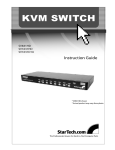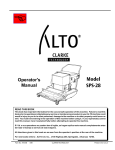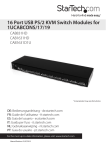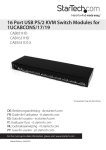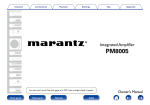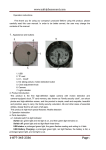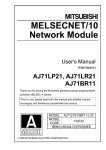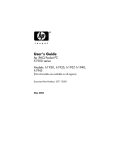Download 8 Port 1U Rack Mount USB PS2 KVM Switch with OSD
Transcript
8 Port 1U Rack Mount USB PS2 KVM Switch with OSD SV831HD SV1631HD *actual product may vary from photos DE: Bedienungsanleitung - de.startech.com FR: Guide de l'utilisateur - fr.startech.com ES: Guía del usuario - es.startech.com IT: Guida per l'uso - it.startech.com NL: Gebruiksaanwijzing - nl.startech.com PT: Guia do usuário - pt.startech.com For the most up-to-date information, please visit: www.startech.com Manual Revision: 09/28/2011 FCC Compliance Statement This equipment has been tested and found to comply with the limits for a Class B digital device, pursuant to part 15 of the FCC Rules. These limits are designed to provide reasonable protection against harmful interference in a residential installation. This equipment generates, uses and can radiate radio frequency energy and, if not installed and used in accordance with the instructions, may cause harmful interference to radio communications. However, there is no guarantee that interference will not occur in a particular installation. If this equipment does cause harmful interference to radio or television reception, which can be determined by turning the equipment off and on, the user is encouraged to try to correct the interference by one or more of the following measures: • Reorient or relocate the receiving antenna. • Increase the separation between the equipment and receiver. • Connect the equipment into an outlet on a circuit different from that to which the receiver is connected. • Consult the dealer or an experienced radio/TV technician for help. Use of Trademarks, Registered Trademarks, and other Protected Names and Symbols This manual may make reference to trademarks, registered trademarks, and other protected names and/or symbols of third-party companies not related in any way to StarTech.com. Where they occur these references are for illustrative purposes only and do not represent an endorsement of a product or service by StarTech.com, or an endorsement of the product(s) to which this manual applies by the third-party company in question. Regardless of any direct acknowledgement elsewhere in the body of this document, StarTech.com hereby acknowledges that all trademarks, registered trademarks, service marks, and other protected names and/or symbols contained in this manual and related documents are the property of their respective holders. Instruction Manual Table of Contents Introduction.............................................................................................1 Installation...............................................................................................1 Cascade Configuration............................................................................................................................. 2 Operating Your KVM Switch..................................................................2 Push Buttons................................................................................................................................................ 2 OSD Operations.......................................................................................................................................... 3 OSD Function Keys.................................................................................................................................... 4 Hot Key Commands................................................................................7 Changing Your Configuration...............................................................9 Keyboard Mapping (SV831HD, SV1631HD only)....................... 9 Troubleshooting......................................................................................11 Specifications...........................................................................................12 Technical Support...................................................................................14 Warranty Information.............................................................................14 Instruction Manual i Introduction Thank you for purchasing a StarTech.com 1U KVM switch. Our universal KVM switches let you control either 8 (SV831HD) or 16 (SV1631HD) USB or PS/2 computers using only one PS/2 keyboard, mouse, and monitor. Our slim 16-port PS/2 switch (SV1631D1U) lets you connect 16 PS/2 computers using only one PS/2 keyboard, mouse, and monitor. Switching between your PCs is easy thanks to pushbutton or hotkey commands. These slim KVM switches take up only 1U of space in your cabinet and use rear cable connections for maximum space efficiency. Each KVM can be cascaded to support 64 (SV831HD) or 136 (SV1631HD, SV1631D1U) computers and support both Manual and Auto scan modes for easy monitoring of your PCs. Packaging Contents • 1 x StarView KVM Switch (SV831HD, SV1631HD, SV1631D1U) • 1 x power adapter (9V 600mA DC) System Requirements • • • • 1 x PS/2 mouse (6-pin mini-DIN male connector) 1 x PS/2 keyboard (6-pin mini-DIN male connector) 1 x HD-15 monitor (Male connector) SV831HD, SV1631HD: StarTech.com’s 2-in-1 USB KVM cables or 3-in-1 PS/2 KVM cables • SV1631D1U: StarTech.com’s 3-in-1 PS/2 KVM cables Installation This section will guide you through the hardware installation of your KVM switch. Please read through this section carefully and complete each step in the order listed. 1. Make sure all computers and devices are powered off. 2. Plug a PS/2 keyboard, PS/2 mouse, and monitor into the labelled keyboard, mouse, and monitor Console ports on the back of the KVM. 3. Attach each of your managed computers to your StarView KVM switch’s PC ports using ultra-thin KVM cables. The SV831HD and SV1631HD are capable of using either 2-in-1 USB or 3-in-1 PS/2 cables. The SV1631D1U uses 3-in-1 PS/2 cables. Use the cables to connect one of the PC ports on the back of the switch to the computer’s keyboard, mouse, and video ports. Note: These instructions are for a single KVM switch only. For information on cascading multiple KVMs, see Cascade Configuration below. 4. Plug the 9V DC power adapter into the power port on the KVM. 5. Turn on your computers. Note: After the initial power up, you can hot-plug additional computers or slave KVM switches without having to power down your KVM. Instruction Manual 1 Cascade Configuration You can connect a second level of KVMs to one or more of your Master KVM switch’s PC ports. The KVM switches connected to the Master switch are know as Slaves. Once connected, the KVM switches will automatically configure themselves as either Masters or Slaves. You can only connect an equal or “smaller” KVM to the Master KVM. For example, a 16-port Master KVM switch can have both 16-port and 8-port slaves. An 8-port Master KVM switch can only have 8-port KVM slaves or lower. The 8-port KVM can support 64 PCs, with 8 8-port Slave KVMs, each connected to 8 PCs. The 16-port KVM can support 136 computers, with 8 16-port Slave KVMs, each connected to 16 computers. The Slave KVM’s must be connected to the Console, not the A~H ports. To cascade your KVMs, use a 3-in-1 PS/2 KVM cable to connect one of your Master switch’s PC ports to the Slave switch’s Console ports. When turning on your cascaded switches, turn on the Master switch before turning on any of the others. Operating Your KVM Switch To toggle between computers, you can use the hot-key commands, OSD (On-Screen Display) menu or by using the pushbuttons. Push Buttons The LEDs on the KVM switch indicate which computers are turned on (solid green) and which computer is selected (solid red). The indicator flashes red when in Auto or Manual Scan mode. You can press any of the corresponding pushbuttons to select the active computer. On the 16 port models, Port 1 and Port A share the same pushbutton, as do Port 2 and Port B, etc. To select Ports 1 through 8, press the pushbutton once. To select Ports A through H, press and hold the pushbutton for two seconds. Alternatively, if Port 1 is currently selected and you want to select Port A, you can press the pushbutton once to switch to Port A. The K/M Reset function reconfigures your system without powering down your computers or your KVM switch. To reset the switch, press and hold the front-panel 1 and 2 buttons simultaneously. The Auto-Scan function automatically scrolls through your connected computers. Press and hold the frontpanel 7 and 8 buttons simultaneously to enter Auto Scan mode. Instruction Manual 2 OSD Operations By hitting the left <CTRL> key twice within two seconds, you may see the ‘Hotkey Menu’ if it is enabled (an OSD option). Or, by hitting the left <CTRL> key three times within two seconds, you will see a ‘KVM MENU’ screen showing a list of the computers with corresponding channel addresses, names and status. The port number (or channel address) of the currently selected computer is displayed in red in the top right of the screen. The device name is green if the device has power and is ready for selection or white if it has no power. The OSD menu automatically updates the color when it is activated. On the 16-port models, use the <Page Up> and <Page Down> keys to view the other 8 computers. Use the <UP>, <DOWN>, 1~8, or A~H keys to highlight a computer and <ENTER> to select it. Instruction Manual 3 Press <ESCAPE> to exit the OSD menu and remove the OSD menu from the screen. A triangle mark on the right side of the screen indicates the port is cascaded to a Slave KVM; the number at the left of the triangle mark shows the number of ports the Slave has. With that port highlighted, press <ENTER> to bring up a screen listing the computers connected to that Slave. The name of the Slave KVM will be shown at the upper right corner of the OSD menu. An eye mark on the right side of the screen indicates that the computer has been selected to be monitored in Scan mode. You can switch this mark on and off using function key <F2>. Press <ESCAPE> to exit the OSD and to return to using the selected computer. The computer name is shown on the screen. OSD Function Keys You can use the function keys when the OSD menu is active. Function key <F1> Edits the name of a computer or a Slave KVM. First, use the <UP> and <DOWN> arrow keys to highlight a channel then press <F1> followed by name entry. Your name can be up to 14 characters long. Valid characters are A to Z, 0 to 9, and the dash character. Lowercase letters are converted to uppercase. Press <BACKSPACE> to delete a letter one at a time. Non-volatile memory stores all name entries until you change, even if the unit is powered down. Function key <F2> Marks a computer to be scanned by switching the eye mark on or off. First, use the <UP> and <DOWN> arrow keys to highlight the device, then press <F2> to switch its eye mark on or off. If Scan Type is Ready PC + Eye (see Function key <F4>), only the powered and eye-marked computers will be displayed in Scan mode. Function key <F3> Locks a device (a computer or a Slave) from unauthorized access. To lock a device, use the <UP> and <DOWN> arrow keys to highlight it, then press <F3>. Now, enter up to 4 characters (A to Z, 0 to 9, dash) followed by <ENTER> as new password. A Securityenabled device is marked with a lock beside its channel number. To permanently disable the security function from a locked device, highlight it, press <F3> then enter the password. If you want to access the locked device temporarily, simply highlight it and press <ENTER>. Enter the password and you can access the device. The device is automatically re-locked once you switch to another device. During Scan mode, OSD skips the security-enabled device. Instruction Manual 4 If you forget the password, the only way to permanently erase all passwords is to press and hold pushbuttons 1 and 2, then press and hold pushbuttons 7 and 8. Release 7 and 8 then release 1 and 2. Function key <F4> More functions are available by hitting <F4>. A new screen pops up displaying the functions described below. Most of them are marked with a triangle indicating there are options to choose from. Using the <UP> and <DOWN> arrow keys, select the function and press <ENTER>. Available options will be shown in the middle of the screen. To select an option, use the <UP> and <DOWN> arrow keys then press<ENTER> to select the option. You can press <ESCAPE> to exit at any time. Auto Scan In this mode, the KVM automatically switches from one power-on computer to the next sequentially in a fixed interval. During Auto Scan mode, the OSD displays the name of the selected computer. When Auto Scan detects any keyboard or mouse activity, it suspends the scanning until activity stops; it then resumes with the next computer in sequence. To abort Auto Scan mode, press the left <CTRL> twice, or press any front button. Scan Type and Scan Rate set the scan pattern. Scan Type (<F4>: More\Scan Type) determines if scanned computers must also be eye mark selected. Scan Rate (<F4>: More\Scan Rate) sets the display interval when a computer is selected before selecting the next one. Manual Scan Scans through power-on computers using keyboard control. Scan Type (<F4>: More\ Scan Type) determines if scanned computers must also be eye mark selected. Press the up arrow key to select the previous computer and the down arrow key to select the next computer. Press any other key to abortthe Manual Scan mode. Audio Stick An optional multimedia module can be LINKed to the back of each StarView for selecting microphone and stereo speaker signals. There are two options for Audio Stick: On and Off. When set to On, audio selection follows computer selection. When set to Off, audio selection stops following computer selection. Off mode is useful if you want to listen to a particular computer’s audio signal while operating other computers. The non-volatile memory stores the Audio Stick setting. Instruction Manual 5 Scan Type Ready PC + Eye: In Scan mode, scans through only power-on and eye-marked selected computers. Ready PC: In Scan mode, scans through all power-on computers. Eye only: In Scan mode, scans through any Eye-selected computer regardless of power status. The non-volatile memory stores the Scan Type setting. Scan Rate Sets the duration of a computer displayed in Auto Scan mode. The options are 3 seconds, 8 seconds,15 seconds and 30 seconds. The non-volatile memory stores the Scan Rate setting. Keyboard Speed StarView offers a keyboard typematic setting that overrides the typematic settings in the BIOS and Windows operating system. Available speed options are Low, Middle, Fast and Faster as 10, 15, 20 and 30 characters/sec respectively. The non-volatile memory stores the Keyboard Speed setting. Hotkey Menu When you hit the left <CTRL> key twice within two seconds, the Hotkey Menu appears displaying a list of hot-key commands if the option is On. The Hotkey Menu can be turned Off if you prefer not to see it when the left <CTRL> key is hit twice. The nonvolatile memory stores the Hotkey Menu setting. CH Display Auto Off: After you select a computer, the channel address and name of the computer will appear on the screen for 3 seconds then disappear automatically. Always On: The channel address and name of a selected computer and/or OSD status displayed on the screen all the time. The non-volatile memory stores the CH Display setting. Position You can choose where the selected computer name and/or OSD status is displayed on your screen during operation. The actual display position shifts due to different VGA resolution, the higher the resolution the higher the display position. The non-volatile memory stores the Position setting. UL as Upper Left UR as Upper Right LL as Lower Left LR as Lower Right MI as Middle Instruction Manual 6 Country Code for Sun (SV831HD, SV1631HD only) Sun keyboards of different languages have different layouts. This KVM switch can emulate a Sun keyboard for a specific language type (or country). Select the proper country code that matches all your Sun computers. Function Key <F5> (SV831HD, SV1631HD only) Switches the Sun mark on or off. The Sun mark indicates that the port is connected to a Sun server. First, use the <UP> and <DOWN> arrow keys to highlight the device, then press <F5> to switch its Sun mark on or off. When a Sun-marked port is selected, the KVM will translate the keys from a PS/2 keyboard to a Sun keyboard. For more information see Keyboard Mapping on page 10. ESC: To exit the OSD, press the <ESCAPE> key Hot Key Commands A hot key command is a short keyboard sequence to select a computer, activate a computer scan, etc. A hot-key sequence starts with two Left Control keystrokes followed by one or two more keystrokes. A built-in buzzer generates a high-pitched beep for correct hot-key sequences and a low-pitched beep for errors or bad key combinations that will not be carried out. The short form hot-key menu can be turned on as an OSD function (<F4>: More\ Hotkey Menu) every time the left <CTRL> key is pressed twice. • Left Ctrl refers to the <CTRL> key located at the left side of the keyboard. • 1~8/A~H refer to the number keys 1 to 8 at the upper row of the keyboard (Do not use the keypad atthe right of the keyboard) and character keys A to H (case insensitive). Selecting a Computer To select a computer by hot-key command you need to know the device’s channel address, which is determined by the StarView connection. For a computer connected to a Master KVM, the address is represented by the PC port number (1~8 or A~H). For example, to access the PC plugged into port 7 of the Master KVM switch, type: left Ctrl + left Ctrl + 7 For a computer connected to a Slave KVM, you need to know the channel address of the Slave unit (1~8) and then the channel address of the device (1~8 or A~H). (Please note that only Master’s PC 1 to PC 8 ports can be connected to a Slave.) For example, to access the computer plugged into port C of the Slave KVM Switch that is plugged into Port 6 of the Master KVM, type: left Ctrl + left Ctrl + 6 + C Instruction Manual 7 Auto Scan Auto Scan automatically scans through power-on computers at a fixed interval: left Ctrl + left Ctrl + F1 When Auto Scan detects any keyboard or mouse activity, it suspends the scanning until activity stops; it then resumes with the next computer in sequence. The length of the Auto Scan interval (Scan Rate) is adjustable (see Scan Rate on the following page). To abort the Auto Scan mode, press the left Ctrl key twice. Note: Scan Type (See “OSD Function Keys: F4”) determines whether eye mark is necessary during AutoScan. Manual Scan Manual Scan enables you to manually switch back and forth between power-on computers: left Ctrl + left Ctrl + F2 Press the up or down arrow to select the previous or next computer in sequence. Press any other key to abort the Manual Scan. Note: Scan Type (See “OSD Function Keys: F4”) determines whether eye mark is necessary during Manual Scan. Scan Rate Scan Rate sets the duration between switching to the next computer in Auto Scan mode: left Ctrl + left Ctrl + F3 The StarView gives off one to four beeps indicating scan interval of 3, 8, 15 and 30 seconds respectively. Keyboard Typematic Rate You can adjust the keyboard typematic rate (given in characters/sec). This setting overrides the keyboard typematic rate of your BIOS and any operating system. left Ctrl + left Ctrl + F4 The StarView gives off 1 to 4 beeps indicating 10, 15, 20 and 30 characters/sec respectively. Instruction Manual 8 Audio Stick An optional multimedia module can be LINKed to the back of each StarView for selecting microphone and stereo speaker signals. There are two options for Audio Stick: On and Off. When set to On, audio selection follows computer selection. When set to Off, audio selection stops following computer selection. It is useful if you want to listen to a particular computer’s audio signal while operating other computers. left Ctrl + left Ctrl + F5 The StarView gives off 1 or 2 beeps corresponding to On and Off respectively. Changing Your Configuration After the initial power up, any device (either a KVM or a PC) can be added or removed from any PC x port on the KVM without having to power down the Master KVM Switch. Make sure that devices are turned off before connecting them to the Master KVM switch. Note: After changing your configuration, the OSD will automatically update to reflect the new configuration. Keyboard Mapping (SV831HD, SV1631HD only) These KVMs are able to emulate a Sun keyboard and mouse when a computer is marked with a Sun in OSD menu by Function key <F5>. A Sun keyboard has more keys than a standard PS/2 keyboard. These extra keys are simulated by tapping the lowerright Ctrl followed by one of the function keys on the PS/2 keyboard (i.e. combo key). For instance, tap the lower-right Ctrl key, and then tap the function key F7 toactivate Open for a Sun computer. Instruction Manual 9 Standard Keyboard Map to Sun Keyboard Map to Mac Keyboard right<CTRL>, <1> right<CTRL>, <2> right<CTRL>, <3> right<CTRL>, <4> Power right<CTRL>, <F1> Stop right<CTRL>, <F2> Again right<CTRL>, <F3> Props right<CTRL>, <F4> Undo right<CTRL>, <F5> Front right<CTRL>, <F6> Copy right<CTRL>, <F7> Open right<CTRL>, <F8> Paste right<CTRL>, <F9> Find right<CTRL>, <F10> Cut Print Screen F13 Scroll Lock F14 Pause Break F15 right<CTRL>, <H> Help right <Windows> key right - right <Command> key left <Windows> key left - left <Command> key <Menu> key Compose right <ALT> Alt Graph right <OPTION> left <ALT> ALT left <OPTION> Instruction Manual 10 Troubleshooting If you are experiencing trouble with your devices, first make sure that all cables are connected to their proper ports and are firmly seated. You may also want to try resetting the devices by pressing and holdingthe front-panel 1 and 2 pushbuttons. Mouse does not work. Make sure there is only one mouse driver installed in each computer. Monitor works, but keyboard and mouse do not. Make sure you haven’t swapped the keyboard and mouse cables VGA image is not clear. You may be using poor quality VGA cables. Make sure you are using UL-2919 rated, doubleshielded VGA cables. No OSD screen or screen image. You may have selected a power-off computer. Use the pushbuttons or to select a computer that is turned on. There is a keyboard error on boot. You may have a loose keyboard connection. Make sure your keyboard cables are well-seated. The letters on the TFT LCD display are blurry or have shadows. You may have improper resolution settings. Under the Control Panel, set the VGA output of your computers to match the highest resolution of the LCD monitor with “Large Font” selected. Master/Slave does not work or there is a double OSD. Make sure that the slave’s Console port is connected to one of the Master’s PC ports. Perform a KVM Reset. Make sure that you have removed all power sources from the Slave unit before connecting it to the Master KVM switch. The Up and Down arrows don’t work in manual scan mode. Make sure more than one computer is turned on. Manual Scan only works with power-on computers. Check the Scan Type (from the OSD menu) and make sure you have selected the proper computers. Auto Scan does not work, the StarView beeps and the indicators flash red. Make sure more than one computer is turned on. Auto Scan only works with powered on computers. Check the Scan Type (from the OSD menu) and make sure you have selected the proper computers. Press the Left Control key twice or press any front pushbutton to abort the Auto Scan. Instruction Manual 11 OSD menu is not in the proper position. The OSD menu has a fixed resolution and its size varies depending on the monitor. Use <F4> More/Position (from the OSD menu) to move the OSD menu to a different location. Cannot select a computer connected to a Slave. Make sure that the Slave’s Console port is connected to one of the Master’s PC ports. Only ports PC1 to PC8 can be connected to Slaves, even if the Master KVM has 16 PC ports. Only one level of Slave KVMs is allowed. Keyboard strokes are shifted. Press both Shift keys. Specifications SV831HD SV1631HD User Ports 1 1 Computer Ports 8 16 Cascade control PC number Up to 64 Up to 136 2-in-1 USB KVM 2-in-1 USB KVM 3-in-1 PS/2 KVM 3-in-1 PS/2 KVM 8 16 Hot plug and play Yes Yes Hot key control Yes Yes Rack mountable 19” industry standard 19” industry standard 3, 8, 15, 30 3, 8, 15, 30 s seconds econds Programmable scan pattern Yes Yes Computer name entry 14 characters per computer 14 characters per computer Cable Type Front panel control Auto scan interval Instruction Manual 12 Security control cable length (max) VGA Computer connector Console Connectors: Mouse Keyboard Monitor Dimensions (HxWxD) Power Supply (min) Instruction Manual SV831HD SV1631HD 4 characters per computer 4 characters per computer 100 ft (30m) at Console 100 ft (30m) at Console PS/2: 100 ft (30m) at PC PS/2: 100 ft (30m) at PC USB: 16 ft (5m) at PC USB: 16 ft (5m) at PC 1920x1440, DDC2B 1920x1440, DDC2B 8 x HD-DB-15 female 16 x HD-DB-15 female 1 x PS/2 female 1 x PS/2 female 1 x PS/2 female 1 x PS/2 female 1 x HD-DB-15 female 1 x HD-DB-15 female 1.7 x 17.2 x 7.0 in. 1.7 x 17.2 x 7.0 in. (44 x 436 x 180 mm) (44 x 436 x 180 mm) 9V DC 600mA 9V DC 600mA 13 Technical Support StarTech.com’s lifetime technical support is an integral part of our commitment to provide industry-leading solutions. If you ever need help with your product, visit www.startech.com/support and access our comprehensive selection of online tools, documentation, and downloads. Warranty Information This product is backed by a three year warranty. In addition, StarTech.com warrants its products against defects in materials and workmanship for the periods noted, following the initial date of purchase. During this period, the products may be returned for repair, or replacement with equivalent products at our discretion. The warranty covers parts and labor costs only. StarTech. com does not warrant its products from defects or damages arising from misuse, abuse, alteration, or normal wear and tear. Limitation of Liability In no event shall the liability of StarTech.com Ltd. and StarTech.com USA LLP (or their officers, directors, employees or agents) for any damages (whether direct or indirect, special, punitive, incidental, consequential, or otherwise), loss of profits, loss of business, or any pecuniary loss, arising out of or related to the use of the product exceed the actual price paid for the product. Some states do not allow the exclusion or limitation of incidental or consequential damages. If such laws apply, the limitations or exclusions contained in this statement may not apply to you. Instruction Manual 14 Hard-to-find made easy. At StarTech.com, that isn’t a slogan. It’s a promise. StarTech.com is your one-stop source for every connectivity part you need. From the latest technology to legacy products — and all the parts that bridge the old and new — we can help you find the parts that connect your solutions. We make it easy to locate the parts, and we quickly deliver them wherever they need to go. Just talk to one of our tech advisors or visit our website. You’ll be connected to the products you need in no time. Visit www.startech.com for complete information on all StarTech.com products and to access exclusive resources and time-saving tools. StarTech.com is an ISO 9001 Registered manufacturer of connectivity and technology parts. StarTech.com was founded in 1985 and has operations in the United States, Canada, the United Kingdom and Taiwan servicing a worldwide market.


















